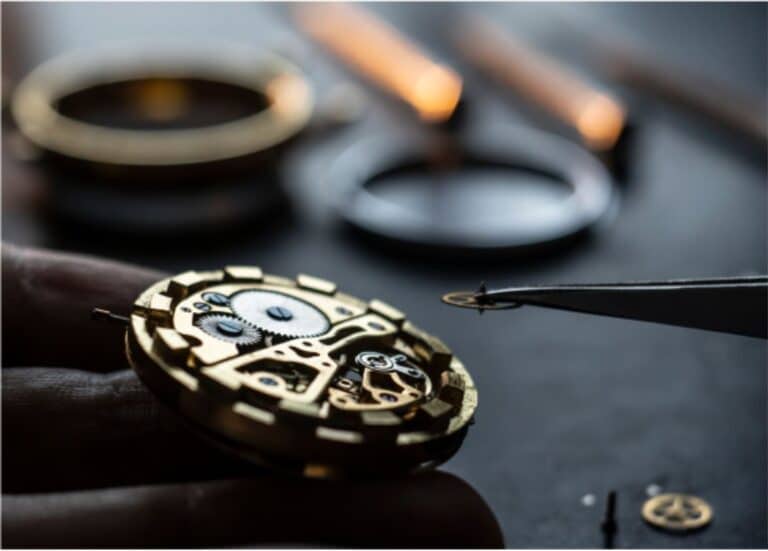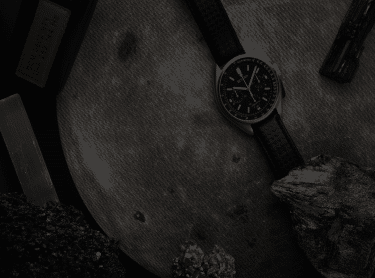Pendant-set pocket watches were inspired by the desire for convenience and ease of use in everyday personal timekeeping, especially as watches became more widely worn in the 19th century. Unlike earlier key-wound models that required a separate tool to wind and set the time, pendant-set watches allowed both functions to be controlled from a single crown located at the top of the case. This design not only eliminated the need to carry a key but also made watches more accessible, compact, and user-friendly—appealing to a growing middle class seeking practical and stylish timepieces for daily wear.
We know that your pocket watch is important to you and understand that the sentimental value more often than not outweighs the monetary value. Our expert watchmakers strive to make sure your watch can be worn for many years to come.
Pocket Watch Repair



Simple watch
mailing process
Free estimates &
return shipping
Restoring timepieces
since 1983
Pocket Watch Repair



Simple watch mailing
process
Free estimates & return
shipping
Restoring timepieces
since 1983
POCKET WATCH REPAIR

Bringing Life Back to Timepieces Once Thought Unfixable
We understand that your pocket watch holds sentimental value that often far outweighs its monetary worth. That’s why our expert watchmakers are dedicated to ensuring your cherished timepiece can be worn and enjoyed for many years to come.
Whether your watch needs preventative care to keep it running smoothly or a complete restoration for a timepiece that has seen better days, we have you covered. From sourcing rare parts to tackling repairs others have deemed impossible, no job is too big or too small. Our services range from simple tune-ups to intricate, full-scale restorations, all with the goal of preserving your watch’s legacy.
Comprehensive Pocket Watch Repair Services
We offer a wide range of repair services tailored to meet your needs:
✔ Pocket Watch Movement Overhaul
Expert craftsmanship and reliable service for precise movement overhauls.
✔ Pocket Watch Crystal Replacement
Times Ticking is your go-to for crystal replacement, offering expert care and precision.
✔ Pocket Watch Stem & Crown Repair
Reliable repair for critical components such as stem and crown repair.
✔ Pocket Watch Service
Times Ticking is your trusted choice for professional and reliable watch service.
✔ Vintage Pocket Watch Repair & Restoration
Bring sentimental timepieces back to life.

Why Choose Times Ticking for Your Pocket Watch Repair
Your pocket watch is more than just a timepiece—it’s a connection to cherished memories and a symbol of timeless craftsmanship. Whether you need routine maintenance or vintage pocket watch repair, entrusting your watch to experienced professionals ensures its longevity and performance for years to come.
At Times Ticking, we know the sentimental value of your watch often outweighs the monetary value. Our expert watchmakers are dedicated to preserving your watch’s legacy, from simple tune-ups to complete restorations.
No matter how challenging the repair—whether sourcing rare parts or restoring a vintage piece—we take pride in breathing new life into your beloved timepiece.


Specialized Pocket Watch Repairs by Times Ticking
Expert Care for Every Watch Style & Collection
We specialize in repairing popular pocket watch collections. Learn more about the history of these collections:
Key-Wind Pocket Watch Repair >
The key-wind pocket watch was inspired by the early need for a practical and consistent method to wind and set portable timepieces before the advent of crown mechanisms. Emerging in the 17th century and widely used through the mid-19th century, these watches required a separate winding key inserted into a small arbor on the back (for winding) or front (for setting the time). This design evolved from the mechanics of spring-driven clocks, with watchmakers in England, France, and Germany adapting it for smaller, personal use. Though eventually replaced by stem-wound systems, key wind watches laid the foundation for early horological portability and precision.
We know that your pocket watch is important to you and understand that the sentimental value more often than not outweighs the monetary value. Our expert watchmakers strive to make sure your watch can be worn for many years to come.
Lever-Set Pocket Watch Repair >
Lever-set pocket watches were inspired by the need for greater accuracy and security in timekeeping, especially during the 19th-century expansion of railroads. As rail travel grew, so did the need for precise synchronization of train schedules to prevent collisions. The traditional stem-set mechanism was too easily adjusted by accident, posing a serious risk in the railroad industry. To solve this, watchmakers—particularly in the United States—developed the lever-set system, which required the user to pull out a small lever near the dial before setting the time. This design ensured the time couldn’t be changed unintentionally, making it a reliable standard for railroad-approved watches and a critical innovation in professional-grade horology.
We know that your pocket watch is important to you and understand that the sentimental value more often than not outweighs the monetary value. Our expert watchmakers strive to make sure your watch can be worn for many years to come.
Minute Repeater Pocket Watch Repair >
Minute repeater pocket watches were inspired by the need to tell time in the dark before electric lighting or luminous dials existed. Developed in the late 17th century and refined in the 18th and 19th centuries, these complex watches chime the hours, quarters, and minutes on demand using small hammers and gongs inside the case. They were especially useful for the wealthy who wished to discreetly check the time in theaters, bedrooms, or carriages, blending technical mastery with elegance. The complication became a hallmark of high horology, showcasing the pinnacle of watchmaking craftsmanship.
We know that your pocket watch is important to you and understand that the sentimental value more often than not outweighs the monetary value. Our expert watchmakers strive to make sure your watch can be worn for many years to come.
Railroad Grade Pocket Watch Repair >
Railroad grade pocket watches were inspired by the critical need for precise timekeeping in the rapidly expanding 19th-century railroad industry, where even slight discrepancies in time could lead to deadly collisions. After a tragic train accident in 1891 near Kipton, Ohio—caused by an engineer’s watch stopping for just four minutes—railroads implemented strict standards for timepieces used by conductors and engineers. These watches had to meet rigorous specifications: high accuracy, lever-set movements to prevent accidental time changes, bold Arabic numerals, open-face dials with the crown at 12 o’clock, and at least 17 jewels. Brands like Hamilton, Elgin, and Waltham in the U.S. became synonymous with these robust and reliable timepieces.
We know that your pocket watch is important to you and understand that the sentimental value more often than not outweighs the monetary value. Our expert watchmakers strive to make sure your watch can be worn for many years to come.
GOOGLE WATCH REPAIR REVIEWS
What Our Customers Are Saying:
Heartfelt Testimonials on Watch Repair
I found Times Ticking on the internet. The last time I had a watch repaired locally it cost more than the watch did new. I got it back just like new 2 weeks later and 2,000 miles away. HIGHLY recommended. Times Ticking was prompt, inexpensive, and even phoned when they got my watch and told me in advance what it would cost to repair.
Their service was grade A!!! They're quick and professional; they always kept me updated with status of my watches. Their work is flawless which they stand behind, to me most importantly. They speak to you as if you're an old friend asking for help; in which they're always happy to do. Times Ticking; a place where you can ask an old friend for help.
I cannot speak to the local facilities or sales staff. I am an internet customer who took a chance and sent my prized Accutron watch across the country to folks I do not know and have never met. This was a big decision which took several weeks to discern. I am thrilled with my decision and am planning to send my Dad’s watch in for repair. The difference? This time there is no hesitation whatsoever.
I was thrilled that they were able to repair and clean up a watch that I had inherited from my mother. It looks great and works great. The service was fast. The person who called me about the watch was very friendly and seemed grateful for my business. I would highly recommend them to anyone and will use them again if the need arises. So refreshing to receive such good customer service these days!
I highly recommend Times Ticking for watch repair. Jesse & crew know their stuff and even take the time to talk with you. They communicate very friendly/professionally and most of all the prices are more than fair for such craftsmen skills! My opinion: They are like the American Restoration of watches.
POCKET WATCH REPAIRS
A Selection of Watches We've Repaired
POCKET WATCH REPAIR PROCESS
How To Send Your Watch For Repair:
Step–By–Step
Get your pocket watch repaired, no matter where you live. We make it simple to send in your watch for repair and service. All estimates are free, and we offer free return shipping on repaired watches.
**Your watch repair, watch movement
replacement is guaranteed for one year.
HISTORY OF POCKET WATCHES
The Legacy of Pocket Watches: A History of Precision, Style and Innovation
Pocket watches originated in the early 16th century as portable adaptations of spring-driven clocks, gaining popularity among European nobility as symbols of status and innovation. Early models were crafted in Germany, England, and later Switzerland, often worn on chains and ornately decorated. The invention of the balance spring in the 17th century greatly improved accuracy, and by the 18th and 19th centuries, pocket watches evolved into essential tools for coordination in industries like railroads, especially in the U.S. with makers like Waltham and Elgin.
Their legacy blends technical ingenuity with cultural significance, bridging art, utility, and timekeeping across centuries.
ABOUT TIMES TICKING

Customer satisfaction is our top priority, which is what keeps people coming back for all their watch repair needs.
A Journey of Excellence in
Watch Repair Since 1983
POPULAR WATCH BRANDS
Browse Other Popular Watch Brands We Service
We can repair ANY watch, including but not limited to the following brands






-
-
- sales@timesticking.com
- 801-991-1097
-
- Times Ticking Repair CenterP.O. Box 566Kaysville, UT 84037
-
Times Ticking Retail Store
1201 North Hill Field Road
#2044 Layton, UT 84041
Get In Touch About Your Watch Repair Today!

-
- sales@timesticking.com
- 801-991-1097
-
- Times Ticking Repair CenterP.O. Box 566Kaysville, UT 84037
-
Times Ticking Retail Store
1201 North Hill Field Road
#2044 Layton, UT 84041







